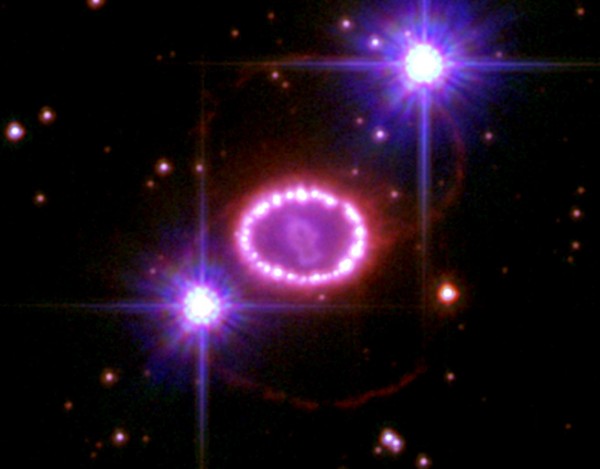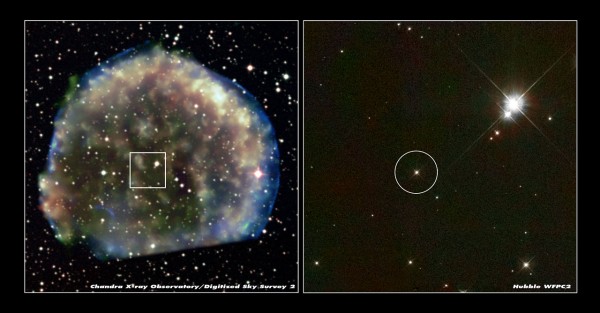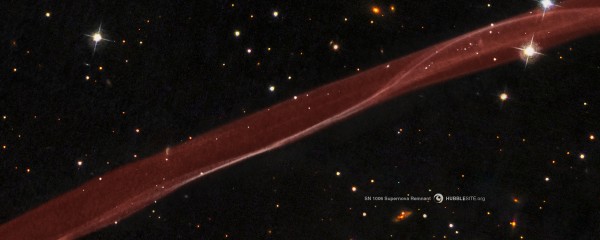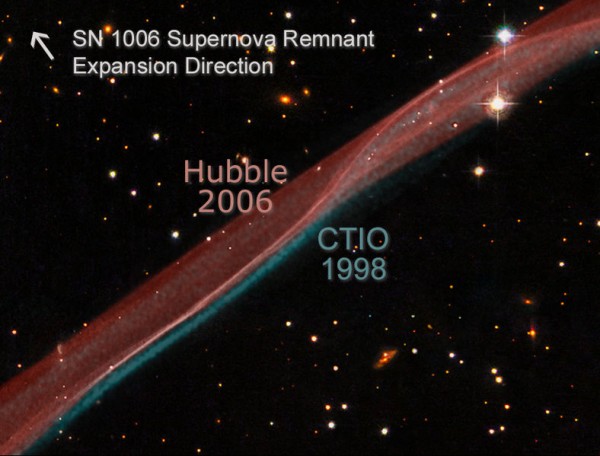When I had satisfied myself that no star of that kind had ever shone before, I was led into such perplexity by the unbelievability of the thing that I began to doubt the faith of my own eyes.
-Tycho Brahe
One of the great things that the Hubble Space Telescope has given us is a whole slew of images of supernovae and remnant of past supernovae, from recent ones like SN 1987a

to supernovae that are hundreds of years old, like Tycho Brahe's supernova from 1572. In fact, Hubble is so powerful that it actually found the companion star that resulted in the Supernova exploding in the first place!

But one of the remarkable things about these supernovae is that their outer layers -- the gases blown off by the explosion -- are still expanding!
Let me introduce you to the first supernova ever recorded in human history: the supernova of 1006!
These gases are hot, and so are best viewed by an X-ray telescope; Chandra was the one that snapped the above image. But there are ribbons of gas that glow at the right temperature that they emit visible light, and the Hubble space telescope can see them! Take a look for yourself. (And, like all the images in this post, click for a huge, full-screen version.)

Hubble took this picture in 2006, and it's awfully pretty (and will remind some of you of Star Trek: Generations). The ribbon of gas is about 7,200 light years away, which makes imaging it in any detail an amazing feat!
But what's remarkable about this ribbon is that a different large telescope, CTIO, imaged it back in 1998, eight years prior. And what do you suppose we see if we overlay those two images on top of one another?

The ribbon is moving, and quickly! (Remember, it's 7,200 light years away!) It must be moving awfully quickly to notice a change in its position over just eight years, and what did we find? Exactly what we'd expect: the ribbon is expanding away from the center of the explosion!
Not exactly a groundbreaking find, but a wonderful confirmation that this catastrophic event, which will trigger the formation of many new stars, works exactly the way we think it does, all while giving you your choice of fantastic desktop wallpapers!
So enjoy a light Friday, and I hope your weekend is a blast!
- Log in to post comments


Is the supernova remnant of SN 1572 a white dwarf? I thought all supernova remnants were either black holes or neutron stars.
T-rex,
I don't know what was wrong with me when I wrote that; that's a G2 star in that image (the same type as our Sun), and it's thought to be the companion star that gave up its mass to the white dwarf that went supernova!
(And then, yes, became a black hole or neutron star.)
Thanks for the catch, and shame on me!
SN 1572 is in the constellation Cassiopeia, what I always called the big W,(as a child).The ancients named this constellation due to her beauty and vain.
I, on the other hand, seem to relate this constellation to the 1963 movie "It's a Mad, Mad, Mad, Mad World".
I always get a chuckle when I see "the big double U" in the fall sky..."a great comedy".
And of course in my extended imagination (the guy that died)is SN 1572, and his remnants affect the actions of the others...sorry for the somewhat OT.
http://www.youtube.com/watch?v=C3rzidagq6o
Have they analyzed the light to see if the expanding gas is loaded up with trans-iron elements?
Hi Ethan,
Beautiful images, slightly off subject tho, sorry for that. You talk on previous posts about Cern and the search for the Higgs Boson. My question is, if string theory is as widely accepted as it appears to be within the scientific community, then why are we looking for the higgs boson, doesn't string theory dictate that its the vibration of strings that give particles/matter its mass? IE: the different vibrations/oscillations of the strings give matter its different properties. Apologies if this is outside your scope,
rgds,
JD.
Hi Ethan,
I am a devoted follower of your blog. You are a great teacher and your posts are usually fascinating. Please consider writing about the following scenario at some point in the future. Assume that the solar system is going to be destroyed by a black hole or supernova. When will we first realize our fate? How long after that will life on earth (at least human life) be extinguished? What will we observe? I wonder whether it will be sudden and invisible, or drawn out and spectacular.
Thanks!
Vijay
I think that the universe is very big.
Bloke1, if I may;
This may not be the answer that you are looking for,
The standard model predicts a higgs and string theory is a mathematical model.
Each model allows one to advance a few paces forward until that model is proven exhausted.
Each model can guide us and sometimes more than one model can be correct. Usually the model that allows one to advance the furthest is the most fruitful, however some models can teach, yet lead away from the main objective.
Politics and human emotion plays a small role for the independent scientist and depending on the integrity of the scientist working for industry or government as well, which to my understanding is quite high in this field.
The quantitative search has proven fruitful in the past, with the population rising, a greater percentage of the mass of humanity has increased the technological advancement along with the dissemination of knowledge through the technical improvement of availability.(your PC)
Ezample-http://www.citizensky.org/
The more relevant viewpoints you obtain, the clearer the picture.
Thanks "Sphere Coupler", I appreciate the reply...I guess we'll have to wait and see what they do discover, cheers.
The public is also getting tired of special interest lying just to line their own pockets by attacking the integrity of the scientific method, a method that is reliable and has brought us the future.
http://www.guardian.co.uk/environment/2010/may/06/climate-science-open-…